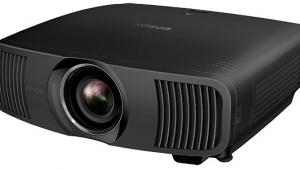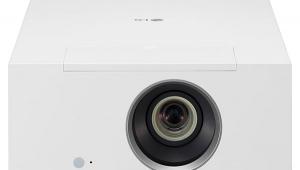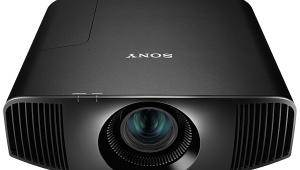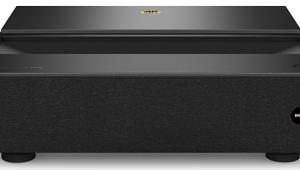Sony VPL-VW50 "Pearl" Projector SXRD Projector Further Measurements and Comments
Our sample had over 400 hours on it by the time it was ready to return to Sony, yet as you'll see in below it still had substantial light output and showed no sign of degraded color balance.
I did differ a bit from Shane in my preferred settings. For starters, I tweaked the color temperature a bit. Different test tools, slightly different results. I recommend at least 100 hours of use prior to calibration, and an hour or two of warmup on the day of calibration to make sure the lamp is fully stabilized.
I did end up with a slightly higher color temperature across much of the brightness range than Shane, but it still fell within a range of 6550K to 6700K from 30-100IRE (and within 0.004 of the correct x/y coordinates for the D6500 standard at all points). When I tried to correct this further, the color temperature at 20IRE dropped a bit lower than I prefer. But the results were still outstanding, and my measurements were not different enough from Shane's, shown in his review, to plot here.
I agree that Gamma3 is the best option (the others, including Off, were too light). I measured a gamma of 2.2 to 2.3 from 30IRE to 60IRE with the Advanced Iris set to Auto 2, dipping to a low of 2.0 at 80IRE. This might explain a slight lightening of the image I sometimes saw in brighter scenes (less noticeable in Auto 2 than Auto 1).
Sony's ImageDirector2 allows custom gamma curves to be set using a connected PC, and is provided with the Pearl. I didn't really feel the need for it, but if I'd had more time to spend with the projector it would have tickled my curiosity to experiment with it.
As with Sony's higher-end VPL-VW100 "Ruby" (see here and here), the Wide and Normal Color Space settings produced virtually the same measured color points, though differences in the relative brightness of the colors were clearly visible between the two settings. The color points themselves weren't particularly accurate, with red and green more oversaturated than blue. The errors weren't great enough to be visually objectionable or cartoonish, but I wish Sony would make the Normal setting truly accurate (as they did in the Qualia 004).
The Wide color mode also worked for me, but I did not find that it produced consistently excessive saturation so did not make any compensating reductions in the red and green RCP Color adjustments. I did see a bit too much saturation in red in the darkest scenes (faces lit by torchlight, for example), but it was always believable.
I did prefer the Auto 2 Advanced Iris setting (Shane went with Auto 1). Auto 2 did slightly lower the measured gamma. In other words, the mid-brightness range was a little dimmer in Auto 2, which provided more "snap" to the image at the same peak brightness setting. This may seem counterintuitive, but it's not. We're only talking a few percent of difference here, but for me it made the bright highlights stand out more, resulting in a little more subjective contrast and a more naturally vivid image.
Oddly, though the manual suggests otherwise, the peak contrast ratio measured virtually the same in both Advanced Iris settings. Best case, with the Contrast control set to 80, and the lamp in its Low setting, I measured about 8800:1 in either Advanced Iris option. The peak white in this setup was 17.59 foot-Lamberts and the video black 0.002fL on my 78-inch wide, Stewart Studiotek 130 screen (white, 1.3-gain).
When I repeated this measurement a few days later (this time using the setup I ultimately ended up spending the most time with: Contrast control on 75, lamp Low, Advanced Iris set to Auto 2) the black level had increased slightly to 0.003fL with a peak white of 16.38fL, which dropped the peak contrast ratio to 5460:1.
This difference from the earlier reading merely reflects the difficulty in accurately measuring black levels this low, even with the highly sensitive Minolta LS-100 meter (rated down to 0.001fL). To double check, I suspended a sample of the same screen material three feet from the projector. The far smaller image this produced substantially increased the white and black levels, moving the latter, in particular, well into the light meter's comfort zone. In this setup I measured 5256:1. Surprisingly, this was not substantially different than the final 5460:1 result I obtained on the big screen. This is still a superb contrast ratio for a digital projector.
But, you ask, what sort of contrast ratio might I get if I choose not to use the auto iris function? With the same setup as above (Contrast control on 75, lamp Low) the minimum fixed iris setting produced a peak contrast ratio of 2100:1 (8.4fL peak white, 0.004fL video black). In the maximum setting, I measured 1858:1 (16.72fL peak white, 0.009fL video black). And at the midpoint of 50 the result was 1893:1 (13.25fL peak white, 0.007fL video black). These are respectable numbers, but the image was, for me, far superior with the Advanced Iris engaged.
The Advanced iris does compress brightness a bit at the top end. This isn't an obviously visible flaw, but may contribute to why the best DLP projectors, like the new Sharp XV-Z20000 (Sneak Peek here, full review coming soon), have a more vibrant image, even if they are set for the same peak white output and have a measurably lower peak contrast ratio.
Another explanation for the added "pop" of a DLP may be ANSI contrast. I am not comfortable with ANSI contrast ratios taken off-screen on a video projector because they will be completely accurate only in an all-black environment, a virtual black hole unobtainable in any real-world environment. Even a completely gray room is not sufficient.
But I did measure modified ANSI contrast ratios for both the Sony Pearl and the Sharp XV-Z20000 in my less than black studio, and neither was particularly impressive. I put no stock in the absolute values. But comparative numbers may have some significance. Under the same conditions, the Sharp's ANSI contrast ratio measured nearly 40% higher than the Pearl's.
It's been a year since I've spent quality time with Sony's more upscale VPL-VW100 "Ruby." So when I say that I may actually prefer the Pearl, keep in mind that my comparative impressions of the two projectors are far from fresh. I must also add that today's market landscape provides a far wider variety of reliably outstanding high-definition sources—with the advent of Blu-ray and HD DVD—than we had only one short year ago. That gives the Pearl a real advantage.
One notable, more readily quantifiable difference, however, is in peak light output. The Pearl was considerably brighter than our sample of the Ruby. Put the Pearl's lamp on High, turn the contrast up to 80, and you'll get a peak output of nearly 28fL. In the Auto 1 Advanced Iris mode, this resulted in a peak contrast ratio of 9077:1 (0.003fL video black). An image this bright would be uncomfortably bright on my screen, but it might well work for you on a larger one, or one with less gain. It might also make the image more tolerant of a little ambient light (though we never recommend anything less than the darkest room you can manage for front projection, as that will always produce the best picture). The High lamp setting is, however, significantly noisier than the extremely quiet, Low setting.
There's very little go complain about in the Ruby, either in its measurements or in its performance on real program material. Are there better projectors out there? Yes. But as of December 2006, they will cost you a lot more money. There are no miracles here, just solid engineering resulting in outstanding performance at a remarkably low price.




























































